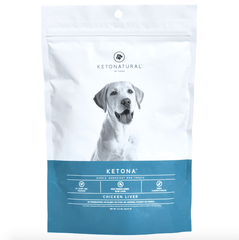Save Money, Save Your Dog.
Join Our Email List For Discounted Pricing and a Free Guide to the Science of Keto Dog Food.
On a high level, the chain of reasoning supporting the claim “your dog should lose some body fat” looks something like this: (1) canine overweight and obesity are “bad” for dogs (they shorten lives and amplify suffering); (2) your dog is overweight or obese; therefore (3) your dog should lose some body fat.
Most dog owners won’t quibble with the contention that overweight and obesity are vile, life-shortening conditions. (Yes, “overweight” is a proper way to say “the state of being overweight.” If you’ve got another concise, politically-correct way to say it, I’m all ears.) We’re usually pretty willing to admit that overweight and obesity are conditions to be avoided (that they’re “bad”), even if we disagree with or don’t fully understand the science supporting that conclusion.
In my experience, where dog owners do tend to push back is when someone tries to tell us that our dogs are overweight or obese. Picking random overweight dogs out of a line-up isn’t very difficult. Admitting that your dog is overweight is another story altogether.
Why is that? Well, it’s pretty simple, really. Being told that your dog is fat is a form of criticism and people don’t really like to be criticized. Labels like “obese” and “overweight” carry implicit judgments, judgments about not just our pets but about us as pet owners. And our fragile egos don’t like that. It “feels bad” on an emotional level. So we try to explain it away (not just to our interlocutor but also to ourselves) by building crappy little arguments that, at least on their face, say otherwise:
“Oh, no, he’s the right size for his breed. He has some Saint Bernard in him, I think.”
“He runs around at the park every day, how could he possibly be overweight?”
“His daddy lived to be thirteen and he was way fatter than this.”
Our tendency to misclassify our overweight dogs as normal weight -- Dr. Ernie Ward of the Association for Pet Obesity Prevention calls this phenomenon the “fat gap” -- is a significant hurdle in the quest to eradicate pet obesity. If we want to do something about pet obesity, we’ve got to get past it.
So here’s how we do that:
Use (and encourage the use of) one of the several quick, easy, simple, publicly-available diagnostic tools that allow us to objectively evaluate our dogs’ body composition from the comfort of our living rooms. Such tools do exist, they’re free, they’re simple, they’re fast, they’re easy, and they’ve been scientifically proven to produce accurate body composition approximations, even when used by untrained laypeople like us.
You’ll be able to read a lot more about all of these tools in my pet obesity e-book (join our mailing list for discounts and pre-ordering instructions), but here’s a quick introduction to one of the better ones:
Waltham and the Royal Canin Weight Management Clinic devised this handy little eight-step algorithmic tool (called the “S.H.A.P.E.” or “Size Health And Physical Evaluation”) to help dog owners diagnose canine body composition without instrumentation, technology, or elaborate measurements. All you need are your hands and five minutes.
Essentially, the S.H.A.P.E. tool walks users through a flow-chart based upon their answers to questions such as “running your fingertips against the direction of the coat can you easily feel the ribcage (without applying pressure)?” Based upon their answers, users classify their dogs according to one of seven body composition categories (from “extremely thin” to “severely overweight”).
A study on the S.H.A.P.E. tool published in the Journal of Nutrition in 2006, showed a good correlation (over 75%) between the results obtained by untrained (and arguably biased) layperson dog owners and experienced operators. In other words, you can trust that the results you get using the test at home will be just as reliable as those your vet would have obtained.
The 2006 study also showed that scores obtained from the S.H.A.P.E. tool correlated very well with body fat mass readings measured by dual-energy X-ray absorptiometry (DXA). In other words, you can trust that the results you obtain from the S.H.A.P.E. test are reliable approximations for those that would be obtained using sophisticated imaging technology. For all you nerds out there, the correlation equation is as follows: Body Fat % = -5.862 + 8.052(S.H.A.P.E. score); S = 5.4920; R2 = 83.6%. If you’re not a statistics geek, just trust me when I tell you that the correlation is quite good.
So there you have it. A simple, quick, reliable, free tool for diagnosing overweight and obesity in your dog, all from the comfort of your home. Like I said before, there are others out there and you can read all about them in my e-book, but for now I urge you to swallow your pride and give the S.H.A.P.E. tool a run this weekend. For your dog’s sake, be rigorous and be honest. If you’re really brave, you can even post the results of your dog’s test in the comments section. Watch, it’s easy:
Kody (3 year-old male Rottweiler) – Ideal/Mildly Overweight
Lucy (7 year-old female English Bulldog) – Lean/Ideal
See? Piece of cake.
Have a great weekend!
- Coach Dan


Related Articles
How Much Does The Farmer’s Dog Really Cost?
5 Signs and Symptoms That Your Dog May Have Diabetes
Learning to Take Pleasure In Being Your Dog's Play Buddy-Drill Sargeant
Dogs, Dog Food and Dogma - A Book About America's Pet Obesity Epidemic
Browse Articles By Category